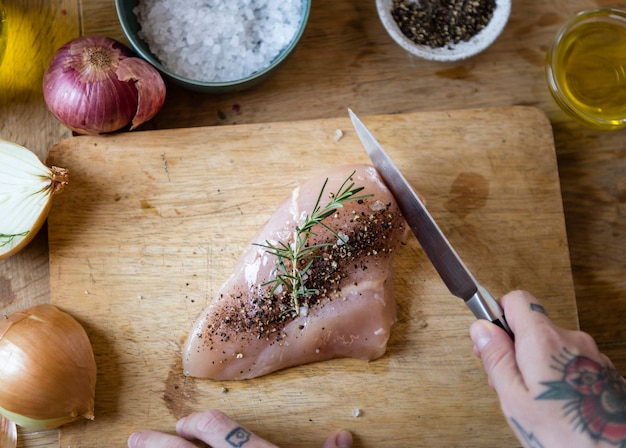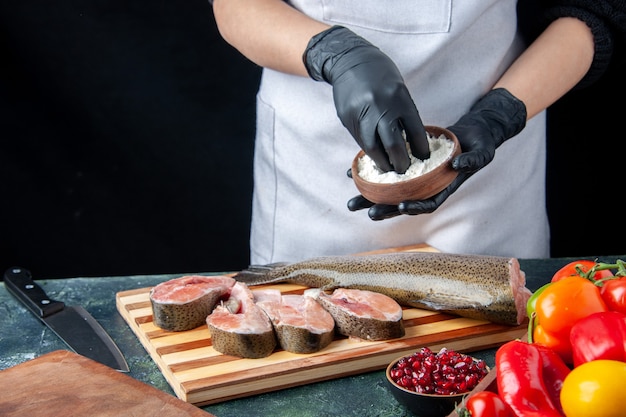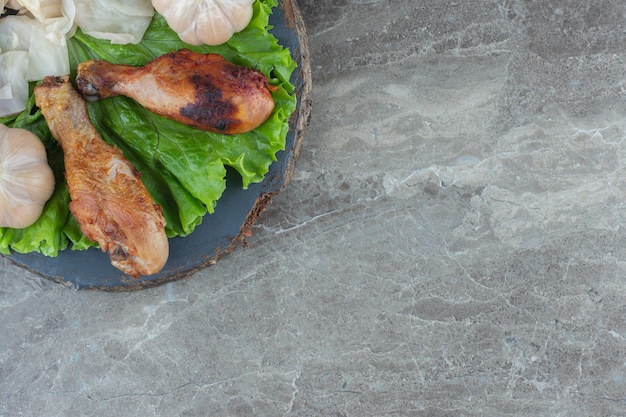Alright, you've got a duck breast in your fridge, and you're ready to tackle this culinary adventure. Maybe you've tried duck before, maybe you're a first-timer. No matter what, you're looking for a foolproof guide to achieving duck perfection, right? Well, you've come to the right place, mate.
I've been a duck enthusiast for years, and trust me, I've seen it all – from dry, disappointing ducks to melt-in-your-mouth masterpieces. But, once you crack the code, there's nothing quite like a perfectly cooked duck breast, that's for sure.
So, grab a comfy spot, because I'm about to share my tips, tricks, and favourite recipes to help you elevate your duck game. We'll cover everything from picking the perfect duck breast to mastering the art of cooking and serving it up like a pro. Let's get started, shall we?
(Part 1) Selecting the Right Duck Breast: The Foundation of a Delicious Dish

Before we dive into the cooking methods, let's chat about choosing the right duck breast. You want one that's plump, firm, and has good marbling. A bit of fat is your friend here, because that's what makes your duck juicy and flavorful.
Duck Breast Types: Understanding the Variations
You'll often see Pekin, Muscovy, and Mallard duck breasts at the butcher's. Pekin ducks are the most popular – they're larger and have a mild flavour. Muscovy ducks are smaller, with a richer, slightly gamier flavour. Mallards, being wild, tend to have a more intense flavour profile.
It's a matter of personal preference, really. A Pekin duck is a safe bet, but if you're feeling adventurous, give a Muscovy or Mallard a try. Don't hesitate to ask your butcher for recommendations – they usually have great knowledge about the different breeds.
Fresh vs. Frozen: Making the Right Choice
Fresh duck breasts are the ideal choice, they have a phenomenal taste. But, let's be real, frozen duck breasts are super convenient. They last longer and are always ready in your freezer.
If you're going with frozen, defrost them properly before cooking. A fridge overnight or a cold water bath is the way to go. Avoid thawing at room temperature, as it can encourage bacteria growth.
The Importance of the Skin: The Secret to Crispy Perfection
Remember the skin? That's a key player in getting a crispy duck breast. Don't trim it off! The skin renders its fat, which adds that fantastic flavour and texture.
(Part 2) Mastering the Art of Cooking Duck: Methods and Techniques

Alright, you've got your duck breast. Now, let's get cooking! There are a few tried and true methods that consistently deliver delicious results.
Pan-Seared Duck Breast: crispy skin, Juicy Inside
This is my go-to method. It's simple, fast, and delivers a delicious result. The trick is to achieve that perfect crispy skin.
- Score the skin: Make some good cuts across the skin. This helps the fat render out and gives you that delightful crunch.
- Season generously: Salt and pepper are classics, but don't be afraid to experiment with herbs and spices. Rosemary, thyme, or garlic are all great options.
- Heat your pan: Use a heavy-bottomed pan over medium-high heat. It should be hot, but not smoking.
- Sear the skin: Place the duck breast skin-side down in the pan. You should hear a satisfying sizzle. Don't move it for 5-7 minutes; let that skin get beautifully crispy.
- Flip and cook: Once the skin is golden brown and crispy, flip the duck breast over and cook for another 2-3 minutes. You don't want to overcook it! Aim for a medium-rare to medium duck breast.
- Rest: This is crucial! Wrap the duck breast in foil and let it rest for 5-10 minutes. This allows the juices to redistribute, making the meat incredibly juicy.
Oven-Roasted Duck Breast: Perfect for Larger Batches
If you're cooking for a crowd, oven roasting is a fantastic option. You can roast multiple duck breasts at once, making it a great choice for gatherings.
- Preheat: Start by preheating your oven to 400 degrees Fahrenheit (200 degrees Celsius).
- Season: Give your duck breast a generous seasoning of salt, pepper, and any other spices you enjoy.
- Use a rack: Place the duck breast on a rack in a roasting pan. This allows the fat to drain, preventing the duck from steaming and ensuring even cooking.
- Roast: Roast the duck breast for 15-20 minutes, or until the internal temperature reaches 135-140 degrees Fahrenheit (57-60 degrees Celsius).
- Rest: Let the duck breast rest for 5-10 minutes before slicing. This allows the juices to redistribute.
Sous Vide Duck Breast: The Ultimate in Tenderness and Control
This is for the serious duck aficionados out there, those who want the ultimate, perfectly cooked duck breast. sous vide cooking is all about precision temperature control. It's an investment, but if you're passionate about cooking and want the best possible results, it's worth considering.
- Season: Start by seasoning your duck breast with salt and pepper.
- Vacuum seal: Vacuum seal the duck breast in a bag. If you don't have a vacuum sealer, you can use a zip-top bag and squeeze out as much air as possible.
- Water bath: Submerge the sealed duck breast in a water bath set to 130-135 degrees Fahrenheit (54-57 degrees Celsius). Maintaining the precise temperature is crucial for optimal results.
- Cook: Cook the duck breast for 1.5-2 hours. This ensures it's cooked perfectly through without overcooking.
- Sear: Once the duck breast is cooked, remove it from the water bath and pat it dry. Now, the fun part – sear the skin for that irresistible crispy finish. Heat a pan over medium-high heat and sear the skin for a couple of minutes per side.
(Part 3) Duck Breast Recipes: From Simple to Spectacular

Now, let's explore some delicious duck breast recipes! I've got a few favourites I'd love to share.
Classic Pan-Seared Duck Breast with Orange Sauce
This recipe is a classic for a reason, it's absolutely divine.
- Pan-sear your duck breast: Follow the pan-searing steps outlined earlier.
- Prepare the sauce: While the duck breast is resting, make the sauce. In a small saucepan, combine 1/2 cup orange juice, 2 tablespoons butter, and 1 tablespoon honey. Bring it to a simmer and cook for a few minutes, until it thickens slightly.
- Slice and serve: Slice the duck breast and drizzle the orange sauce over the top. A sprinkle of chopped fresh parsley adds a beautiful touch of colour.
Duck Breast with Cherry Sauce and Roasted Potatoes
This recipe is a true showstopper, perfect for a special occasion.
- Roast the potatoes: Preheat your oven to 400 degrees Fahrenheit (200 degrees Celsius). roast potatoes, seasoned with salt, pepper, and rosemary, until golden brown and tender.
- Cook the duck breast: While the potatoes are roasting, prepare your duck breast using the pan-searing method.
- Make the cherry sauce: In a small saucepan, combine 1 cup fresh cherries, 1/2 cup red wine, 1 tablespoon sugar, and a pinch of salt. Simmer for 10-15 minutes until the cherries are soft and the sauce has thickened.
- Serve: Once the duck breast is cooked and resting, slice it and serve over the roasted potatoes with the cherry sauce.
Duck Breast with Honey-Soy Glaze and Sesame Noodles
This recipe is a beautiful blend of sweet and savory, an explosion of flavours!
- Cook the noodles: Start by cooking your noodles according to the package instructions. While they're cooking, prepare your duck breast using the pan-searing method.
- Make the honey-soy glaze: In a small bowl, combine 1/4 cup soy sauce, 2 tablespoons honey, 1 tablespoon rice vinegar, and 1 teaspoon sesame oil.
- Toss the noodles: While the duck breast is resting, toss the cooked noodles with the honey-soy glaze, sesame seeds, and chopped green onions.
- Serve: Slice the duck breast and serve it over the sesame noodles. Sprinkle with chopped fresh cilantro for extra flavour.
(Part 4) Sides and Accompaniments: Completing Your Duck Feast
You've got your perfectly cooked duck breast. Now, let's talk about the sides that will elevate your meal to a whole new level. You can go with the classics or try something a bit more adventurous.
Classic Sides: Timeless Choices for a Balanced Meal
You can't go wrong with classics like roasted potatoes. They're always a crowd-pleaser. Roast them with herbs like rosemary or thyme, or add garlic for extra flavour.
green beans are another great option. You can roast, sauté, or steam them. They're a simple and healthy side.
Don't forget about bread. A crusty baguette or a soft roll complements the rich duck flavour perfectly.
Adventurous Sides: Stepping Outside the Box
Feeling a bit bolder? Here are some ideas to add some excitement to your dish.
- Roasted root vegetables: Carrots, parsnips, and beets offer a vibrant, colourful addition to your duck breast.
- Polenta: Creamy polenta provides a lovely contrast to the rich duck. You can keep it simple or add herbs or cheese for extra flavour.
- quinoa salad: Quinoa is a superfood, packed with nutrients and a mild, nutty flavour. Toss it with chopped vegetables and a light dressing.
(Part 5) Sauces and Glazes: Elevate Your Duck Game with Flavour
Sauces and glazes are the finishing touches that make a duck breast truly special. They add another dimension of flavour and bring the entire dish together.
Classic Sauce Options: A Touch of Sweetness
Orange sauce, as mentioned earlier, is a classic for a reason. It's sweet and tart, perfectly complementing the rich duck flavour.
Another popular choice is cherry sauce. It's a bit more intense than orange sauce, with a deep, fruity flavour.
Homemade Glaze: The Secret Weapon
You can make your own glaze! This is a fantastic way to personalize your dish.
Here's a simple honey-soy glaze recipe:
| Ingredients | Amount |
|---|---|
| Soy sauce | 1/4 cup |
| Honey | 2 tablespoons |
| Rice vinegar | 1 tablespoon |
| Sesame oil | 1 teaspoon |
- Combine all ingredients in a small saucepan.
- Bring the mixture to a simmer and cook for 2-3 minutes, until it thickens slightly.
- Brush the glaze over the duck breast during the last few minutes of cooking.
(Part 6) Leftover Duck: Don't Waste That Deliciousness
You've got leftover duck breast? Fantastic! Don't let it go to waste, mate. You can create a whole range of delicious dishes with it.
Leftover Duck Salad: A Healthy and Tasty Treat
Slice up the leftover duck breast and add it to a salad. It goes wonderfully with mixed greens, chopped vegetables, and a light vinaigrette.
Duck fried rice: A Comforting and Savoury Delight
Chop up the duck breast and add it to a pan of fried rice. It's a quick and easy way to use up leftovers and create a tasty meal.
Duck Tacos: A Flavourful and Fun Option
Dice up the duck breast and use it to make delicious duck tacos. Add salsa, avocado, and sour cream for a real treat.
(Part 7) Serving Duck: Presentation Matters
Okay, your duck breast is cooked to perfection, you've got your sides, your sauce – everything is ready. Now, let's talk about serving it up in style.
Serving Style: Plate It Like a Pro
You want it to look good, right? It's not just about the taste, it's about the whole experience. Here are some tips to make your duck breast presentation a winner.
- Slice thinly: Slice the duck breast thinly. It's easier to eat and looks incredibly elegant.
- Arrange beautifully: Arrange the duck breast on a platter with the sides around it.
- Drizzle the sauce: Don't be shy, drizzle the sauce generously over the duck breast.
- Garnish with herbs: Parsley, thyme, and rosemary all look fantastic and add a touch of freshness.
The Art of Carving: A Skill to Master
Carving the duck breast is a bit of an art form. You need a sharp knife, a steady hand, and a bit of practice.
- Hold firmly: Hold the duck breast firmly with one hand.
- Slice evenly: Use the knife to make a series of thin slices along the length of the duck breast.
- Keep the skin intact: Be careful not to cut through the skin. You want to keep it intact for presentation.
(Part 8) FAQs: Duck Breast Cooking Decoded
You've got questions, I've got answers! Let's clear up any doubts you might have.
1. Can I Freeze Duck Breast?
Absolutely! You can freeze duck breast – it's a great way to store it for longer. Just make sure you wrap it tightly in plastic wrap or freezer paper to prevent freezer burn.
2. What's the Best Way to Defrost Duck Breast?
The best way to defrost duck breast is in the fridge overnight. This ensures it thaws evenly and slowly, without encouraging bacteria growth.
3. How Do I Know When My Duck Breast is Cooked?
The best way to tell if your duck breast is cooked is with a meat thermometer. It should reach an internal temperature of 135-140 degrees Fahrenheit (57-60 degrees Celsius) for medium-rare to medium. You can also check the doneness by making a small cut into the meat. The juices should run clear, not pink.
4. Can I Overcook Duck Breast?
Yes, you can overcook duck breast. It'll become dry and tough. Aim for medium-rare to medium, that's the sweet spot for a juicy and flavorful duck breast.
5. What Happens if I Don't Sear the Skin?
You won't get that crispy skin. It's worth the extra effort to sear the skin – it really adds a fantastic texture and flavour to the duck breast.
(Part 9) Conclusion: A World of Duck Delights Awaits
There you have it! My comprehensive guide to perfectly cooked duck breast. I hope you found it helpful and inspiring.
Remember, practice makes perfect. The more you cook duck, the better you'll get at it. Experiment with different recipes, different sides, and different sauces. Don't be afraid to try new things. You might discover a new favourite!
You'll be amazed at how much you can do with a simple duck breast. It's a versatile ingredient that can be used for a wide range of dishes.
So, go out there and cook some delicious duck. Enjoy it!
Everyone is watching

Corn on the Cob: The Ultimate Guide to Perfectly Cooked Ears
Healthy MealsAh, corn on the cob. Just the name evokes images of sunny days, barbecues, and that sweet, juicy flavour that ...

Scallops: The Ultimate Guide to Perfect Cooking
Healthy MealsAh, scallops. Those delicate, sweet, and utterly delicious morsels of the sea. They hold a special place in my...

Spaghetti Squash: The Ultimate Guide to Cooking and Serving
Healthy MealsRemember that time you saw spaghetti squash at the supermarket, looking all bumpy and strange, and thought, "W...

Salmon Cooking Times: Perfect Guide for Every Recipe
Healthy MealsLet me tell you, cooking salmon is an art form. It's all about getting that perfect balance: juicy and tender,...

Ham Cooking Time: How Long to Bake, Smoke, or Boil a Delicious Ham
Healthy MealsAh, ham. It's a classic, isn't it? A real crowd-pleaser, especially around holidays. And when done right, it'...
